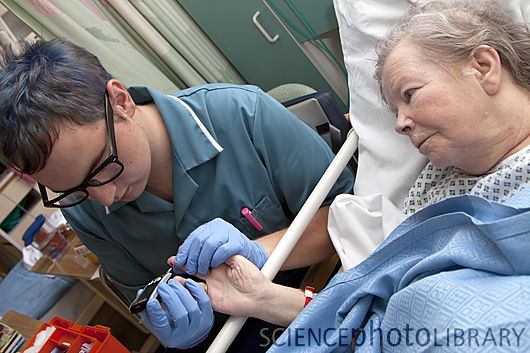
糖尿病患者体内的一种线粒体酶表达异常(图)
美国乔斯林糖尿病中心的科学家在糖尿病患者的骨骼肌细胞中发现了一种线粒体酶的表达抑制,未来开发能激活该酶的相关药物也许可以有效治疗疾病。
这项研究的论文发表在最新一期的《PNAS》杂志上。这种表达受到抑制的酶名为Sirt3,和正常人相比,糖尿病患者中该酶的表达量下调了至少一半以上,它发现于人体的线粒体细胞器中,也许和临床上糖尿病最初期的症状如胰岛素抵抗的形成相关。
论文的通讯作者,生理学部门主任C. Ronald Kahn教授和哈佛医学院药学教授Mary K. Iacocca说道:“这是首次由我们报道了在糖尿病患者的线粒体中具体发生了哪些异常,之前许多研究结果显示那些糖尿病患者中的线粒体功能异常,但始终没找出具体的原因。”
Kahn小组的科学家们研究了Sirt3表达水平的下调是如何影响细胞的新陈代谢的,特别是细胞的胰岛素功能。结果发现,Sirt3表达水平的下调会降低细胞中线粒体的能量代谢效率,随后会产生名为ROS的物质(含氧活性化学分子),它能引起肌肉产生胰岛素抗性。Kahn博士说道:“之前研究均显示早期糖尿病的一个特点是肌肉会产生胰岛素抗性,但却始终不知道这是如何引起的。我们首次报道了诱导其形成的分子机制,它将是未来新的治疗靶点。”
Kahn小组的下一项研究将是找到恢复Sirt3表达水平或提高现有Sirt3活性的方法,这也许可以通过使用药物来实现。如果能将Sirt3的活性提高,也许可以至少逆转一部分Ⅱ型糖尿病的副作用。(生物探索 Jun译)
生物探索推荐英文论文原文摘要:
Sirtuin-3 (Sirt3) regulates skeletal muscle metabolism and insulin signaling via altered mitochondrial oxidation and reactive oxygen species production
Sirt3 is a member of the sirtuin family of protein deacetylases that is localized in mitochondria and regulates mitochondrial function. Sirt3 expression in skeletal muscle is decreased in models of type 1 and type 2 diabetes and regulated by feeding, fasting, and caloric restriction. Sirt3 knockout mice exhibit decreased oxygen consumption and develop oxidative stress in skeletal muscle, leading to JNK activation and impaired insulin signaling. This effect is mimicked by knockdown of Sirt3 in cultured myoblasts, which exhibit reduced mitochondrial oxidation, increased reactive oxygen species, activation of JNK, increased serine and decreased tyrosine phosphorylation of IRS-1, and decreased insulin signaling. Thus, Sirt3 plays an important role in diabetes through regulation of mitochondrial oxidation, reactive oxygen species production, and insulin resistance in skeletal muscle.







